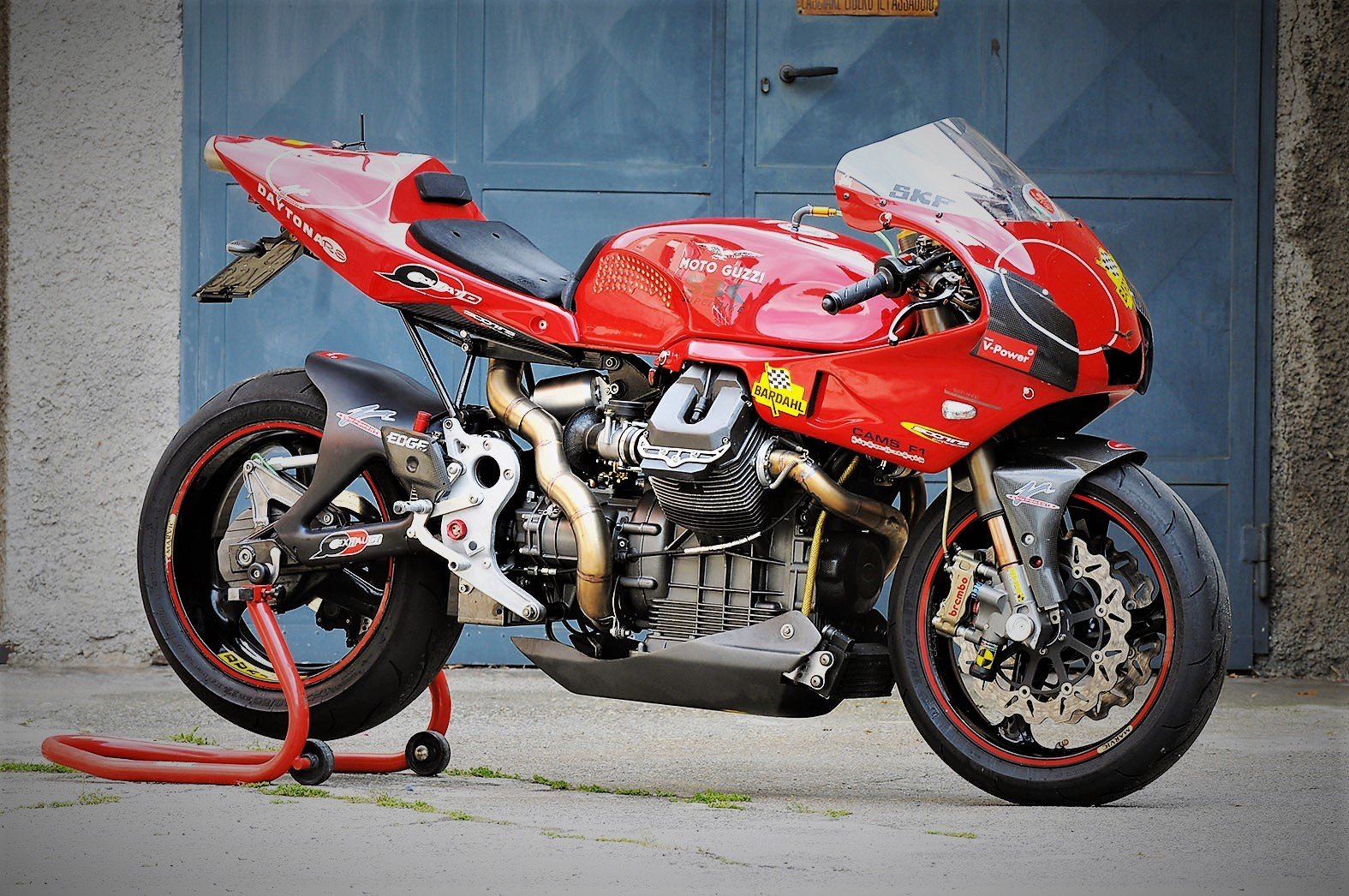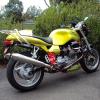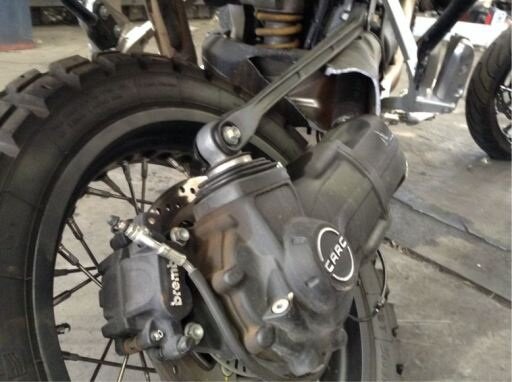-
Posts
5,449 -
Joined
-
Last visited
-
Days Won
276
Content Type
Profiles
Forums
Events
Gallery
Community Map
Everything posted by Lucky Phil
-
It's a simple preventative fix anyway. Drill the threads out of the hole and use a Ducati well nut for the clamp instead. Remove the stress raiser. Basic engineering. My main point was don't get too cocky about the other guys engineering failures, nobody is immune. Ciao
-
Green V11 Sport..... Ciao
-
From the album: lucky phils V11
-
Really. Why? Cracking emanating from a wheel speed sensor retaining clamp tapped hole leads to this result. Ciao
-
Considering they have a running, rideable versions already I'd expect production to start sooner than that. It'll be a long wait for me if they don't start till Sep 22 as I won't buy anything before it's been in production for a few years. Ciao
-
I don't use them to save weight, that's just a secondary benefit. Ciao
-
Then you haven't been around enough #1 damage from anti seize compound use is overtorquing the fastener. I've seen plenty of this. The other one is system contamination from using too much antiseize. Boeing 737 pneumatic control valve regulators come to mind. Ciao
-
True NGK recommend to NOT use any anti seize as the plating on the plug is designed as an "anti seize". Having said that I recently pulled a set of 75,000klm old original plugs out of my car for replacement and the experience wasn't too comfortable. I put anti seize on the new ones and made a note to never let them go more than 50,000klm in future despite what the manufacturer says. Ciao
-
I like this chart. https://www.monarchmetal.com/blog/galvanic-corrosion-common-questions-answered/ Ciao
-
Not sure docc as I try and avoid venturing into the Periodic table and "theoretical outcomes" if my personal experience indicates it's not an issue. Titanium is 22 aluminium is 13, is that bad? Uncoated Titanium can "gall" against itself as in a TI nut on a Ti axle but I've never had an issue on aluminium. Having said that it's recommended to use a copper based anti seize on the threads which I always do. You may remember I used a bit of Ti for bolts and bushes I machined up for my tank mount on the V10 Sport. I'm also considering making Titanium axles for my bike. I've priced the raw material and it's not a massive cost so if I can locate some KT forks I'll do that. Ciao
-
I was doing some research for Joe Caruso on the latest iteration of his aftermarket oil pump and was postulating along with him on the reasoning behind using helical gears in the std pump as opposed to straight cut gears. I was looking at one of my pumps on the bench and the only advantage I could see was that as the gear tooth passed the inlet and outlet ports in the housing it did so in a gradual manner due to the angle of the tooth and not open and shut as a straight tooth would. I thought this would lead to less pressure spikes and a more constant delivery. So after about 3 hours of research I found that I was indeed correct and even found a pressure graph demonstrating the differences. Another puzzle solved and the satisfaction of realising that I had worked it out myself and the thought that maybe just maybe all the time I've devoted to thinking about "engineering" over the last 50 years or so has actually taught me stuff. A rare moment indeed. I once read as a teenager all about the pros and cons of Georotor pumps but have forgotten what they were, lol. Time to revisit. Ciao
-
There's quite a bit of loss through a gear pump. There's the tooth tip to housing clearance and the gear end clearance to the crankcases. With the small volume your hand pump is delivering you'll notice these accumulated losses. I understand your reasoning here with priming but it's a bit of an overkill. The oil cooler really doesn't come into it as it's not in the oil delivery system until the thermostat opens anyway although there will be some leakage and that will gradually fill it until the thermostat opens. On a new engine it's worth running the pump off a hand drill when the front cover is off but otherwise not really necessary. Ciao
-
Yes pretty much all except the 10mm suspension bolts and engine mount bolts. If you turn the heads out on a titanium fastener you're doing something wrong. The beauty of them is they look exactly the same after 50 years as they did the day they were made. If your keeping your bike long term they are worth the money and if you don't then you just spend an hour or so refitting the original bolts when you sell it and use them on the next bike. The majority of fasteners on just about all bikes is M6X25. I can tell you one thing, aircraft don't use any stinking SS fasteners. I'd use a passive plated steel bolt over a SS one every day of the week. Ciao
-
Only that it makes a poor material for a fastener. It's a boating world thing and they need something that can survive a salt laden environment so put up with the negatives. If you want the gold standard in a fastener then use Titanium. All my bikes have a high percentage of Ti fasteners. Light, strong and ductile so they stretch and hold their tension. SS is too hard and lacks ductility so they don't stretch well so lose tension. Ducati tried them as engine cylinder studs at one time and I mean "one time" and had a recall to replace them after they started failing and they were 10mm studs about 180mm long. Junk for fasteners. Ciao
-
There's a difference between a bench test at room temp and no vibration and a switch operating in a 100 degC vibrating environment. Buy a new switch anyway and check the filter and the oil pump pickup screen and the adaptor plate orings which do go hard after a while. Also have a look at the big ends to see if there is metal squeezing out the sides. If you still have no joy then it's likely you'll need to remove the front cover for a look at the pump and drive. Ciao
-
Why not add the manual recommended quantity of oil and then measure the gap? Then you'll know your in the ballpark. Ciao
-
Just replace it and be done with it. They are a known weak ling and probably should be a "hard time" component any way. Ciao
-
Yes the regulator on the early bikes senses the battery voltage off the lights system power wire which is switched by the headlight relay. On the later bikes it doesn't. Ciao
-
No bike deserves the title of a "special" on colour alone. It needs more than that to be classified as a "special" or "limited edition" in my book. Ciao
-
To use on my bike. Ciao
-
Go and buy yourself a set of quality ring open end spanners, same for screwdrivers, a set of feeler gauges, metric 'T" bars, a set of std Allen keys, a quality 10" adjustable spanner a set of 3/8 drive sockets and 1/4 drive sockets and your pretty much covered. Probably about $250 worth in the states. Forget buying individual items if you are serious about your maintenance. Ciao
-
The biggest misunderstanding with oil is the lower viscosity grade. Mention you run your engine on a 0W-40 and people tell you it's too "thin". They think this because they don't understand engine oil viscosity. Here's a simple explanation with regards to viscosity for a FULL SYNTHETIC oil. A 0W-40 oil has higher viscosity at room temperature than it does at engine running temperature. End of story. So the engine is designed to do it's work at around 100 deg C a temp where a 0W-40 oil is less viscous, or thinner than it is at a room temperature. So how can the W weight possibly be too thin? The confusion is because MINERAL based multigrade oils "shear down" over time so they traditionally ran a higher W number (like 20 weight, 20W-50 for example) so if you didn't change the oil and let it shear down all it's "Viscosity improvers" you still had a baseline viscosity that would provide some half decent engine lubrication. You had a floor viscosity level. Modern full synthetic oils simply don't shear down like that so you can use a W viscosity that's very low (remember still more viscous than it is at running temp) to provide much better cold start and cold temp protection and performance because you don't need the "safety net". You can actually use an oil closer to what the engine needs at start up and still have the hot end needs met as well. Ciao
-
It doesn't matter as long as the "loop" is intact. Whatever works best for the shortest length of hose with the biggest radius bends and least stress on the fittings. Stock routing on many things isn't necessarily the best option but sometimes just the easiest way for the production line assembly. Use you engineering judgment. Ciao
-
Yes but it can be translated to the RC .bin file manually via Tunerpro and loaded. Same as I transposed the Centauro maps from a 16M ecu into a 15M ecu. Ciao





